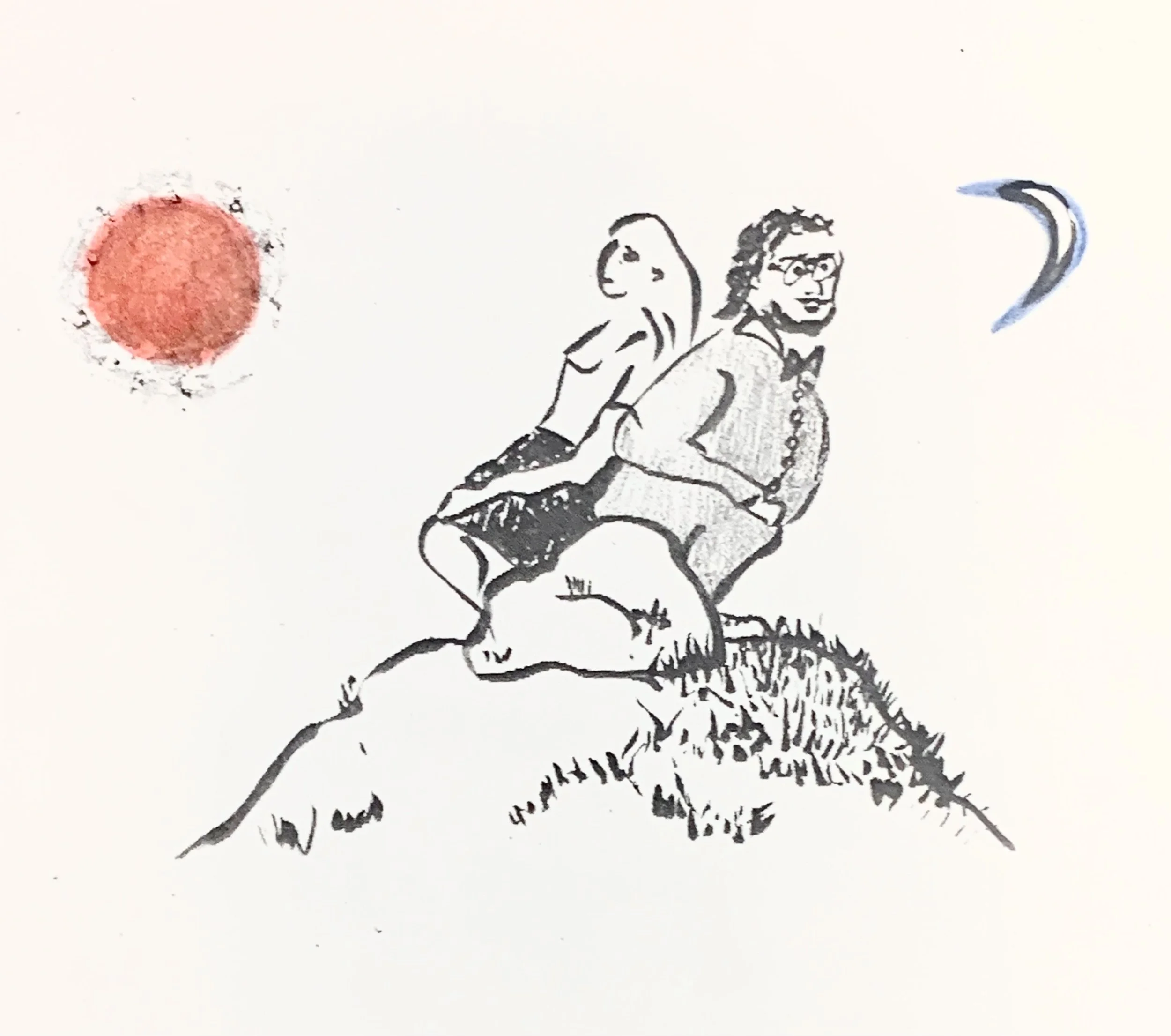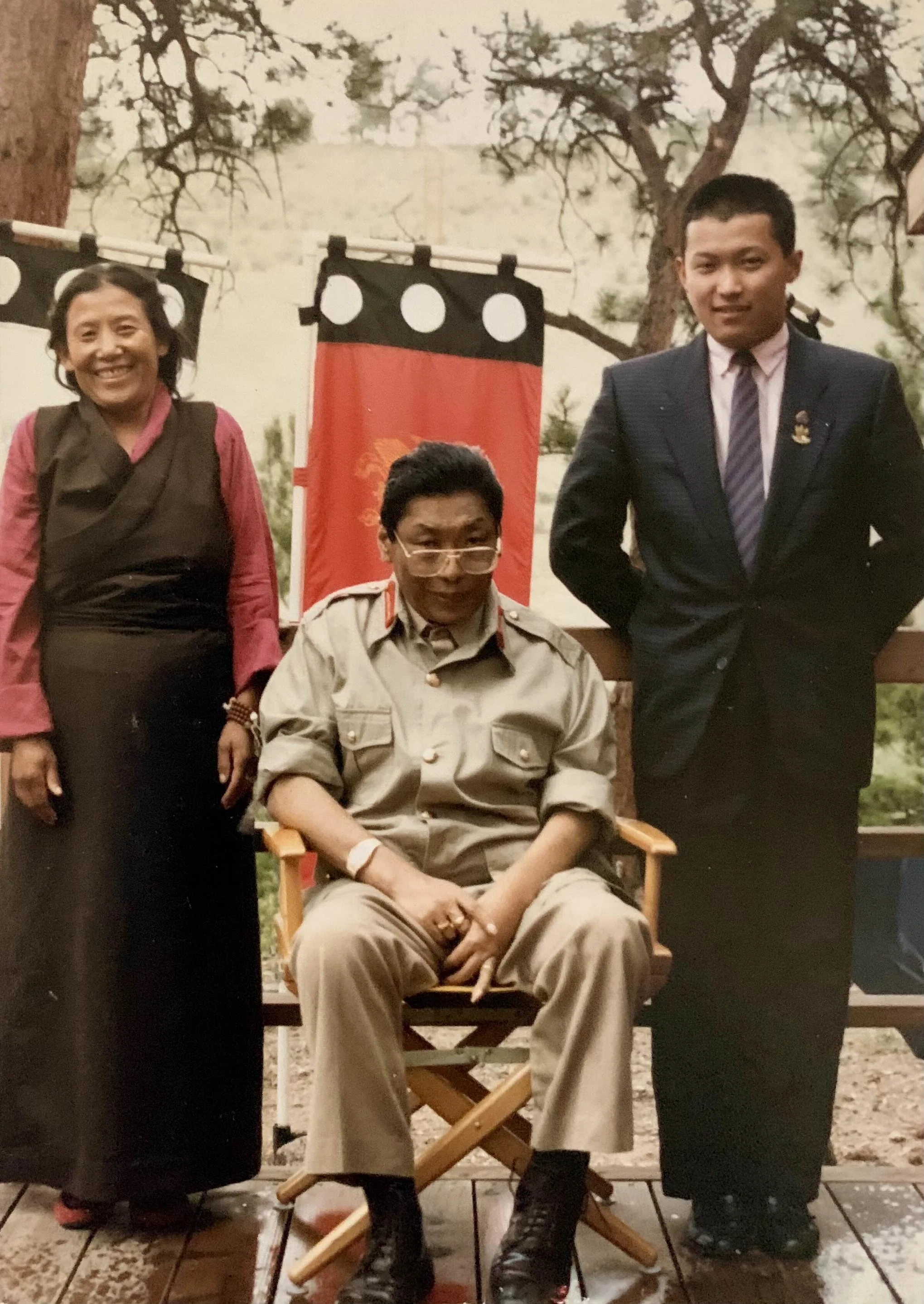Summertime at Marpa House
“It is absolutely important to make the practice of meditation your source of strength, your source of basic intelligence…Stop acting, Stop speeding. Sit and do nothing.”
– Chogyam Trungpa,
Journey Without Goal
In summer of 1999, I moved into Marpa House, a vibrant dharma center in Boulder, Colorado where I was welcome to study and pursue my personal practice for three months. Marpa House carried the blessings of Chogyam Trungpa Rinpoche, so I felt lucky to be there.
On the night of my arrival, the environment was noisy and jarring, evocative of college parties. To my bemusement, a talent show was in full swing. I went straight upstairs, took refuge in my “dorm” room and fell asleep to the din of the celebrants below. (The center’s handsome building prior to its purchase had in fact been a college dormitory; the space assigned to me wasn’t much larger than the bed that was in it, but it had nice lighting and a desk I could use for drawing portraits of the Tibetan Buddhist masters.)
Marpa House offered its residents manifold ways to strengthen their dharma practice 24/7. It certainly tested my humor to live as a neophyte Buddhist nun among thirty lay practitioners and a few folks still shopping for the perfect guru.
The center had a lovely rooftop bedroom suite to accommodate guest rinpoches, and a library too. During my stay (which was extended to 4 1/2 months, thanks to the lobbying effort of a couple longtime residents), I received teachings from masters of the Kagyu and Nyingma lineages, notably Minling Jetsun Khandro Rinpoche, Khenpo Tsultrim Gyamtso Rinpoche, Thrangu Rinpoche, and Tsoknyi Rinpoche. I also met Trungpa Rinpoche’s wives, Lady Kunchok, born in Tibet, and Lady Diana of British origin. At Naropa, the first Buddhist liberal arts university in North America (founded by Chogyam Trungpa in '74), I attended classes led by Dzogchen Ponlop Rinpoche, a special weekend teaching offered by Lama Tharchin Rinpoche, and an informal talk by Sakyong Mipham. Perhaps this line-up of masters and dakinis is what Dungse Thinley Norbu Rinpoche had foreseen months prior when he told me to “go see many lamas.”
Lady Konchok, Chogyam Trungpa Rinpoche and their son, Sakyong Mipham. Photo courtesy of N. L. Drolma; gift from Lady Konchok.
Thrangu Rinpoche, tutor to H.H. the Karmapa, was scheduled to impart the precious “pointing out instructions” on the nature of mind. A Marpa House resident avowed that several students referred to Thrangu Rinpoche with reverential humor as “Mr. Mahamudra.” On the eve prior to Thrangu Rinpoche’s arrival at the dharma center, a vision I had (of figures inseparable from intense white light and nakedly entwined in union, yet beyond concepts of “two” or “one”) prompted me to request an interview with the master.
I bemoaned the lack of supportive housing in the U.S for western Buddhist nuns in the Tibetan tradition and confessed to Thrangu Rinpoche my fatigue as a novice itinerant in dharma robes; finding a place to stay was an ongoing test of fortitude. Dharma is in its infancy in America and my native land isn’t laid back like India or Nepal where a practitioner, ordained or lay, can travel at large and readily book a room in town without having to commit to a longterm lease and pay 2+ months’ rent upfront.
Rinpoche replied with a cheerful smile, “Then give up being a nun.”
How Thrangu Rinpoche said what he said made everything that was heavy suddenly very light and I could not help but laugh. His reply was so unexpected, and seemingly farcical. (I was unaware that Rinpoche was the abbot of the dharma center in Nova Scotia where the renowned Buddhist nun Pema Chodron resides.) Thrangu Rinpoche’s words were a potent reminder that my happiness was up to me. I had no interest in reverting to worldly ways. A vagabond Tibetan Buddhist nun in America is an anomaly; what to do about it? The prevailing conditions were grist for the Dharma mill and they exposed my pride. My distaste for navigating the cultural abyss was pointless. Onerous conditions on the spiritual path expose self-cherishing and strip ego of its excuses; I had “homework” to do.
The hours I spent with Lady Konchok on the rooftop terrace of Marpa House were an extra special highlight of my stay there. Lady Konchok had been a nun in Tibet, and her empathy and candor assuaged my loneliness. She was so down-to-earth. One afternoon, she led me into her kitchen and set about making pan-roasted Indian flatbread and invited me to try my hand at it. When it came time for the fitting of the sun and moon ornaments atop the Great Stupa* of Dharmakaya—a spectacular, joyous event at Rocky Mountain Dharma Center— I was touched by Lady Konchok’s offer to put me up that night in her trailer on the land. I declined the kindness when I saw the modest size of her living quarters and the sheer number of people milling about, wanting to spend time with her.
* A stupa symbolizes the all-pervading essence of enlightened mind and it is constructed to promote peace and liberation from ignorance. This 108-foot stupa is the largest in the U.S. The architectural symbol of the sun represents wisdom and the moon, bodhicitta, the heart of the awakened mind.
Nyoshul Khen Rinpoche in residence at Khachod Dechenling, NYC 1992 (Photo by N. L. Drolma)
Lady Konchok’s warmth inspired me to be more outgoing. I signed up to perform in the talent show at Marpa House; the event was a tradition and held quarterly. The revered Nyoshul Khen Rinpoche had passed into parinirvana on August 27th, and I wished to acknowledge his passing publicly. I was inspired to share poetry that could convey to the Shambhala community a taste of Khenpo’s noble qualities: verse from “The Last Testament” of the 14th century Dzogchen master Longchenpa whom Khenpo venerated; an excerpt from Magic Dance by Thinley Norbu; and a poem on mindfulness by Nyoshul Khenpo.
There was a sweet girl, tall and slim (my body type), who roomed on my corridor at Marpa House, and I asked her if she had a black satin dress and perhaps a string of pearls—or blue jeans and a blue T-shirt—that I could wear as a costume for the talent show. Either alternative would be a stark departure from my maroon wardrobe. My housemate was pleased to help; she was aware that a clique of residents routinely directed incivility toward ordained practitioners. My participation in the talent show just might smash misconceptions about nuns in the Tibetan Buddhist tradition.
Few residents knew I was scheduled to perform. At the sound of the drumroll, I made my way down the stairs to the dining hall area that had been transformed into a nightclub stage. As I righted myself on the barstool under the spotlight, a sudden hush governed the room, and I was handed the mic. I first squinted up at the theatrical lights, and then smiled broadly to the packed rows of theatre-goers. Pin-drop silence erupted into whistles of approval, and wild applause. It’s not often one can win applause simply for wearing jeans and a T-shirt.
◊
Kyabje Alak Zenkar Rinpoche, Tudeng Nima (Photo by M. Ricard)
That summer of 1999, I took a break from dorm life with the Shambhalians and flew to Vancouver to meet with Alak Zenkar Rinpoche.
As it is said, one can’t hide anything from the guru. Why did I feel compelled to tell Zenkar Rinpoche that my portraits of Tibetan masters were to be exhibited at Marpa House? An administrator by happenstance had seen the portraits lining the wall in my room and eagerly asked if I would consent to a public showing. Every two months, Marpa House mounted a revolving display of art on their walls. I agreed to the show, yet had misgivings for there arose within me a distracting three-ring circus of thoughts about how an art exhibition could generate future commissions for portraits. Did I want to get caught up in the worldly concerns of gain, loss, praise and criticism that attend the showing and marketing of art? No, I did not. My drawings were a labor of love in the spirit of guru yoga. But the probability of meeting people who might offer financial support for retreat was appealing. Other practitioners were readily accepting commissions to paint thangkas; manufacturing jewelry with images of deities; recording dharma songs; and performing Chöd on a theater stage.
“You don’t go public with your practice.” Zenkar Rinpoche articulated what I sensed was appropriate for me, yet reluctant to admit.
My peripatetic lifestyle was stripping me of habitual reference points; unrivaled means for acquiring a yogini’s depth of confidence (but not easy). I needed to reflect again and again on the following advice by Dilgo Khyentse Rinpoche:
Portrait of Dilgo Khyentse by N. L. Drolma (watercolor, conté crayon, pencil 24” x 30”).
“A hidden yogi is a practitioner who does not mix with other people and become involved in worldly activities, and who seeks neither fame nor followers. He burns with an irresistible longing for spiritual practice and has seized the root of Dharma—the determination to be free from samsara. Now, you might think: “If I renounce all worldly activity now, what will happen to me later? How am I going to find food, lodging, and all the rest of it?... You will never be a good Dharma practitioner until you are truly sick of ordinary life and know how to be satisfied with whatever you have.”*
I cancelled the art show.
On the last day of my ten-day stay in Vancouver, Zenkar Rinpoche and I were sitting alone at a bus stop. Rinpoche remarked that perhaps his choosing this particular route was a mistake; we had been waiting a verrry long time for the bus. But I was delighted to be in Rinpoche’s company and more than content to wait forever. Zenkar Rinpoche exuded the unaffected majesty of Padmasambhava and simultaneously an extraordinary ordinariness. Without preamble, Rinpoche astonished me with a declaration about himself and the world we live in. I looked into his eyes. Pure love. His eyes were pure love, a shimmering cluster of stars at dawn.
Anyone who fears or pooh-poohs guru yoga is missing out bigtime.
*Source of quote: Dilgo Khyentse’s The Heart Treasure of the Enlightened Ones (Shambhala Publications, Boulder, 1992)




